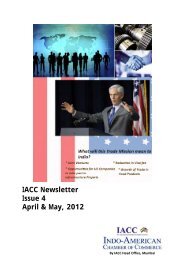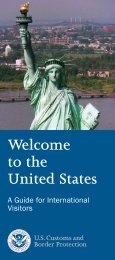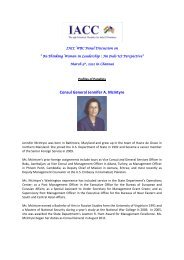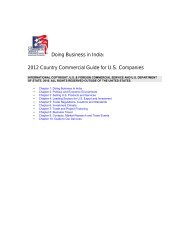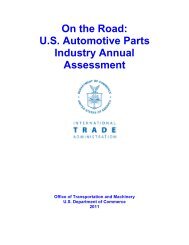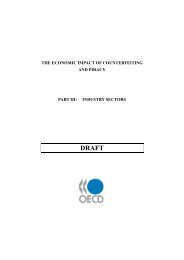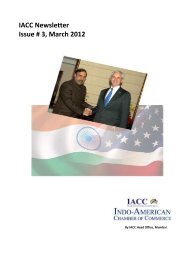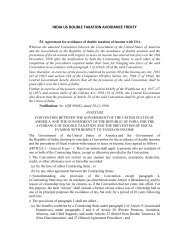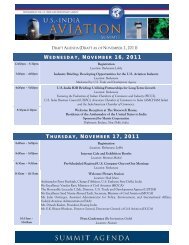Importing into the United States - Indo-American Chamber Of ...
Importing into the United States - Indo-American Chamber Of ...
Importing into the United States - Indo-American Chamber Of ...
You also want an ePaper? Increase the reach of your titles
YUMPU automatically turns print PDFs into web optimized ePapers that Google loves.
country’s procedures to protect against<br />
unlawful transshipments (including an effective<br />
visa system) and <strong>the</strong> implementation of<br />
procedures and requirements similar in all<br />
material respects to <strong>the</strong> relevant procedures<br />
and requirements under Chapter 5 of <strong>the</strong><br />
NAFTA. The <strong>United</strong> <strong>States</strong> Trade Representative<br />
will publish a Federal Register notice when<br />
it designates a country as eligible for preferential<br />
treatment. This information will be available<br />
on <strong>the</strong> Internet at www.ustr.gov and at<br />
www.agoa.gov.<br />
ELIGIBLE ITEMS<br />
Expanded GSP Treatment<br />
AGOA expands benefits available under<br />
<strong>the</strong> GSP program by offering duty-free treatment<br />
to a broader range of products. The President<br />
is permitted to extend duty-free treatment<br />
to imports of essentially all products<br />
except textiles and apparel as long as <strong>the</strong> products<br />
are <strong>the</strong> “growth, product or manufacture”<br />
of: (a) a beneficiary sub-Saharan African<br />
country; (b) are imported directly from a beneficiary<br />
sub-Saharan African country <strong>into</strong> <strong>the</strong><br />
customs territory of <strong>the</strong> U.S.; (c) meet a valueadded<br />
requirement; and (d) <strong>the</strong> President<br />
determines that <strong>the</strong> products are not importsensitive<br />
in <strong>the</strong> context of imports from beneficiary<br />
sub-Saharan African countries. Sub-<br />
Saharan African beneficiary countries are also<br />
exempted from competitive-need limitations.<br />
Approximately 1835 products have been<br />
designated as eligible for duty-free treatment<br />
under <strong>the</strong> GSP program for beneficiary sub-<br />
Saharan African countries. These articles will<br />
be designated by inserting <strong>the</strong> symbol “D” in<br />
<strong>the</strong> “Rates of Duty 1-Special” column of <strong>the</strong><br />
Harmonized Tariff Schedule of <strong>the</strong> <strong>United</strong><br />
<strong>States</strong> for subheadings covering such articles.<br />
A list of products eligible for duty-free treatment<br />
under <strong>the</strong> AGOA has been published in<br />
<strong>the</strong> Federal Register and is available on <strong>the</strong><br />
Internet at www.agoa.gov.<br />
Preferential Treatment for Certain Textile<br />
and Apparel Articles<br />
AGOA provides duty-free and quota-free<br />
benefits to imports of certain textile and<br />
apparel articles produced in eligible sub-<br />
Saharan African countries. In most instances,<br />
<strong>the</strong>se benefits are available regardless of <strong>the</strong><br />
total volume of apparel exported from eligible<br />
countries to <strong>the</strong> <strong>United</strong> <strong>States</strong>. The six broad<br />
categories of textile and apparel articles that<br />
may receive preferential treatment are:<br />
1. Apparel articles assembled in beneficiary<br />
sub-Saharan African countries from<br />
fabric wholly formed and cut in <strong>the</strong><br />
<strong>United</strong> <strong>States</strong> (from yarns wholly formed<br />
in <strong>the</strong> <strong>United</strong> <strong>States</strong>).<br />
2. Apparel articles cut in beneficiary sub-<br />
Saharan African countries from fabric<br />
wholly formed in <strong>the</strong> <strong>United</strong> <strong>States</strong> (from<br />
yarns wholly formed in <strong>the</strong> <strong>United</strong> <strong>States</strong>),<br />
if those articles are assembled in one or<br />
more beneficiary countries with sewing<br />
thread formed in <strong>the</strong> <strong>United</strong> <strong>States</strong>.<br />
3. Apparel assembled from regional and<br />
o<strong>the</strong>r fabric.<br />
This category generally covers apparel<br />
articles wholly assembled in one or<br />
more beneficiary sub-Saharan African<br />
countries from fabric wholly formed in<br />
one or more beneficiary sub-Saharan<br />
African countries from yarn originating<br />
ei<strong>the</strong>r in <strong>the</strong> <strong>United</strong> <strong>States</strong> or one or<br />
more beneficiary sub-Saharan African<br />
countries. However, preferential treatment<br />
will be allowed through September<br />
30, 2004, for apparel articles<br />
wholly assembled in one or more lesser<br />
developed beneficiary sub-Saharan<br />
African countries regardless of <strong>the</strong><br />
country of origin of <strong>the</strong> fabric used to<br />
make such articles.<br />
Preferential treatment of apparel articles<br />
in this category is subject to a cap of 1.5<br />
percent of overall U.S. apparel imports,<br />
growing to 3.5 percent of overall<br />
imports over an eight-year period. The<br />
cap is denominated in square meter<br />
equivalents (SMEs). The first year cap,<br />
applicable for <strong>the</strong> 12-month period<br />
beginning October 1, 2000, is<br />
246,500,393 SMEs.<br />
4. Sweaters, in chief weight of cashmere or<br />
containing 50 percent or more by weight<br />
of wool measuring 18.5 microns in diam-<br />
IMPORTING INTO THE UNITED STATES<br />
47



